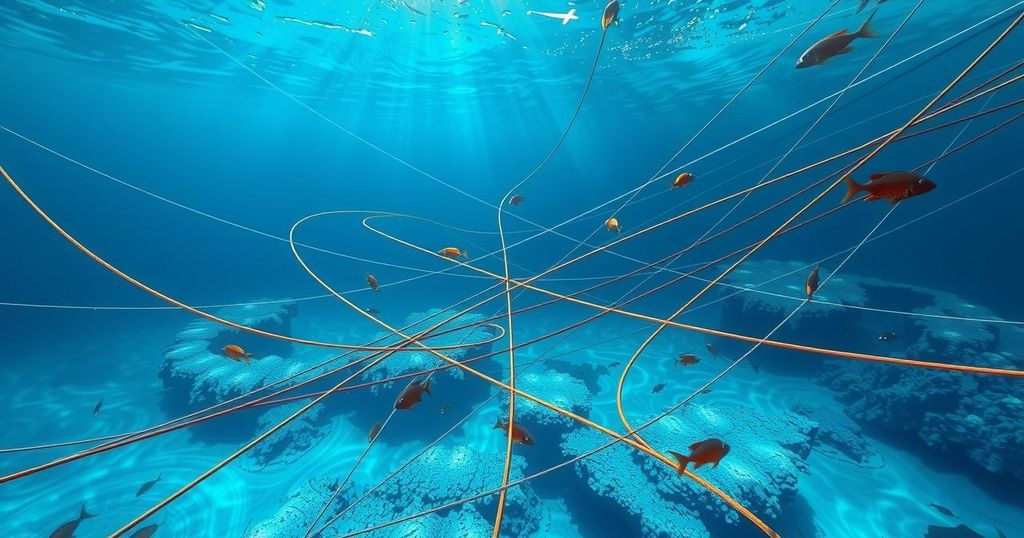Meta’s Project Waterworth aims to build the longest submarine communication cable, enhancing connectivity across five continents. Beyond telecommunications, these cables can facilitate environmental monitoring through SMART technology. However, regulatory issues and financial concerns hinder widespread adoption of sensing cables, despite the urgent need for enhanced oceanic data to combat climate change.
The recent announcement by Meta regarding the construction of Project Waterworth, a 50,000-kilometre submarine communication cable, highlights the ongoing evolution of global connectivity. This extensive infrastructure aims to connect five continents, enhancing technological advancements in nations such as the United States, India, and Brazil. Submarine cables have historically focused on improving telecommunications since the inception of the first cable across the Atlantic in 1858.
Currently, the world boasts approximately 1.4 million kilometres of these vital cables, designed to transmit data at extraordinarily high rates of up to 300 terabits per second. However, the function of submarine cables extends beyond telecommunications; they can be pivotal in environmental monitoring. Recent discussions within the industry emphasize the emerging capabilities of cable systems equipped with sensors to assist in identifying climate change impacts and natural disasters.
SMART cables, an initiative from the International Telecommunications Union, the World Meteorological Organization, and UNESCO, are specifically engineered for environmental monitoring. These cables feature sensors that collect critical oceanic data, such as seismic activity and temperature variations, which are essential for improving early-warning systems for threats like tsunamis and earthquakes. Additionally, OFS cables monitor vibrations in the vicinity, protecting infrastructure from potential disturbances caused by external activities.
Though countries like France and Portugal are investing in these innovative cables, the broader adoption of sensing technologies is hindered by several significant concerns. An outdated regulatory framework, which does not adequately address cables equipped with environmental sensors, complicates the process of obtaining necessary permits. Financial viability also emerges as a crucial issue, as industry leaders question the return on investment for incorporating sensors given the added costs involved.
Furthermore, potential security risks create apprehension, as sensors embedded within cables might be perceived as surveillance devices by some governments. The concerns around data privacy and the vulnerability of these cables to malicious activities impede their widespread approval. Nonetheless, the urgency for enhanced oceanic data cannot be overstated, particularly in understanding climate change impacts.
Increased access to detailed ocean data can provide significant benefits across various industries including shipping, offshore energy, fisheries, and insurance. Enhanced data collection can also support scientific efforts to model climate change phenomena effectively. Current regulatory challenges, however, limit investment in the incorporation of sensing technology, hence stifling potential advancements.
The proposed Waterworth Project can serve as an opportunity to integrate environmental sensors on specified branches, fostering the establishment of a comprehensive public database on ocean observations. Such a database would consolidate and provide access to real-time environmental data, benefiting scientists, policymakers, and industries alike.
While deploying sensors in politically sensitive areas may not be feasible, regions particularly vulnerable to climate change, such as the Pacific, could greatly advantage from scientific monitoring. Responding to these challenges requires proactive measures and investments akin to Portugal’s commitment to SMART cable projects, which demonstrates a pathway for others to follow in advancing public infrastructure to address climate issues.
In summary, submarine cables, especially those like the emerging SMART and OFS technologies, offer significant potential for both enhanced connectivity and vital environmental monitoring. Current regulatory and financial challenges must be navigated to fully exploit these benefits, as the need for comprehensive ocean data grows in urgency amidst climate change. By investing in these technologies, governments can fulfill their duty to protect and understand our environment, paving the way for innovative solutions to global challenges.
Original Source: eveningreport.nz




